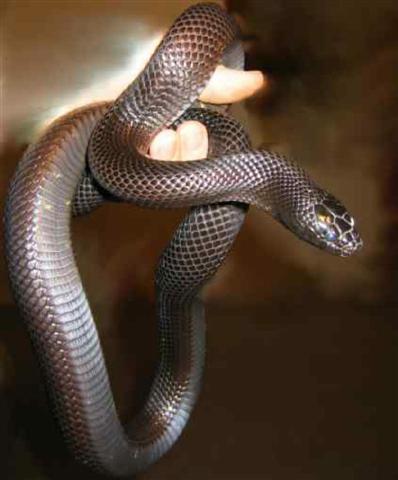Kingsnake - Mexican Black
Sonoran Black Kingsnake, Mexican Black Kingsnake Scientific Name: Lampropeltis getula nigritus
Sat, 12th July, 2025 - 4:18 am GMT
Sponsor Ads:

Alternative Name
Sonoran Black Kingsnake, Mexican Black Kingsnake Scientific Name: Lampropeltis getula nigritusBasic Info
The Mexican Black Kingsnake reaches a size of three to four feet at maturity. They have a shiny black body, and will occasionally have a yellow to white spot pattern. The best of these species are a pure black color. Mexican Black Kingsnakes have very smooth scales.
Health
The Mexican Black Kingsnake is mostly nocturnal. They should be kept at temperatures in the mid 80's, with a basking spot between 90 and 100 degrees Fahrenheit. A water bowl should be present for drinking and bathing. Mexican Black Kingsnakes should be fed raised mice. Breeding The Mexican Black Kingsnake breeds between the months of March and June. They are egg layers, and will lay 6 to 12 eggs in each clutch. The incubation period is 66 to 83 days. Most juveniles have a more conspicuous yellow and white pattern, which fades as the snake gets older. Some individuals are born black, but this is not common.Habitat
They are found mostly in the Sonoran Desert, which extends from Southern Arizona to Central MexicoBehavior
The Mexican Black Kingsnake, also known as the Sonoran Black Kingsnake, is a great snake. They are an exotic animal, being almost a pure, shiny black color. The Mexican Black Kingsnake is a constricting snake. While they are aggressive in the wild, they quickly adapt to captivity, and become quite used to handling. When confronted in nature they will vibrate their tails rapidly in leaves or loose brush to try to simulate a rattlesnake's rattling noise. No kingsnakes have rattles even if the imitation is convincing. Mexican Black Kingsnakes need to be kept separated from other snakes, due to their cannibalistic nature. These snakes are mostly terrestrial, but they won't hesitate to climb a tree to catch a bird. Like all snakes, the Mexican Black Kingsnake may become aggressive during feeding time. This is especially true if they are not handled regularly.Origin
North AmericaHistory
Mexican Black Kingsnakes play an important role in the environment. They help to maintain the rodent and snake population in the Sonoran Desert. . An interesting trait, the Mexican Black Kingsnake has immunity to Rattlesnake venom.Common Foods
feeds on lizards, birds, snakes, eggs, frogs, lizards and small mammalsSponsor Ads:
Until I loved, life had no beauty; I did not know I lived until I had loved. -- Theodor Korner
Kingsnake - Mexican Black
Coded by: BGID® | ALL RIGHTS RESERVED Copyright © 2000-2025
Disclaimer | Privacy | Report Errors / Contact | Credits








 Preparing For China. China is growing their military. China Military Technology - can it keep up with the US?
Preparing For China. China is growing their military. China Military Technology - can it keep up with the US?  versus
versus 

 versus
versus 
 This Thread is about the North Korean Military itself - the kind of army, navy, and air force they have.
This Thread is about the North Korean Military itself - the kind of army, navy, and air force they have. 
 versus
versus 
 versus
versus  versus
versus